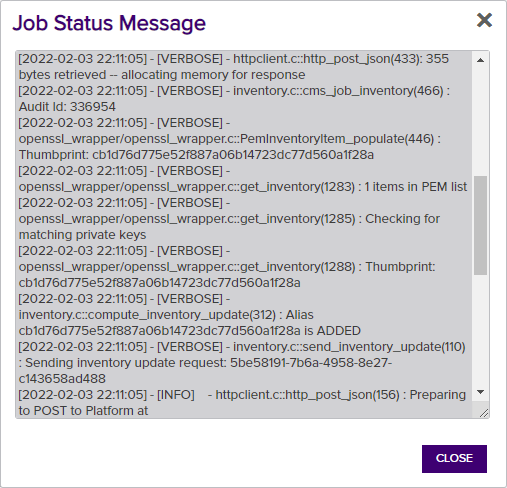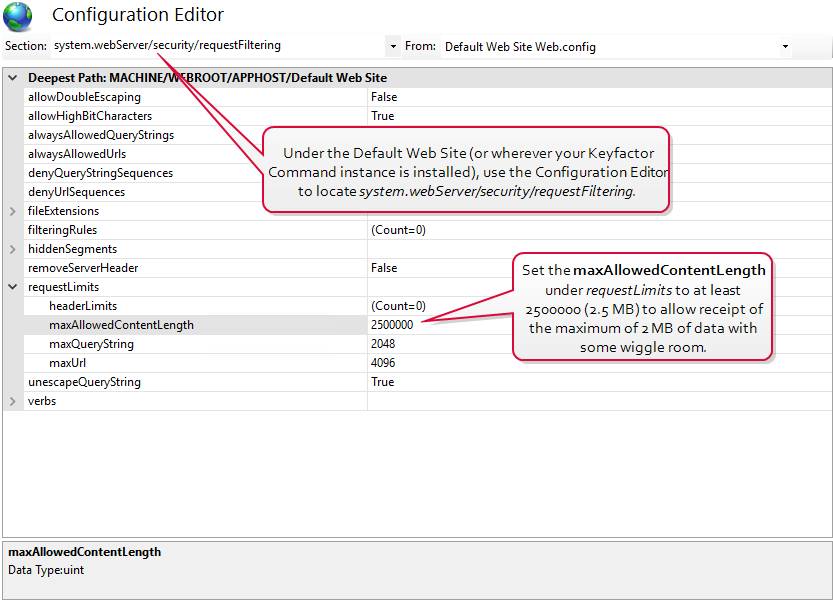Fetch Logs
The fetch logs function is designed to retrieve a portion of the tail end of the orchestrator![]() Keyfactor orchestrators perform a variety of functions, including managing certificate stores and SSH key stores. log for easy review. It is supported for both the Keyfactor Universal Orchestrator
Keyfactor orchestrators perform a variety of functions, including managing certificate stores and SSH key stores. log for easy review. It is supported for both the Keyfactor Universal Orchestrator![]() The Keyfactor Universal Orchestrator, one of Keyfactor's suite of orchestrators, is used to interact with Windows servers (a.k.a. IIS certificate stores) and FTP capable devices for certificate management, run SSL discovery and management tasks, and manage synchronization of certificate authorities in remote forests. With the addition of custom extensions, it can run custom jobs to provide certificate management capabilities on a variety of platforms and devices (e.g. F5 devices, NetScaler devices, Amazon Web Services (AWS) resources) and execute tasks outside the standard list of certificate management functions. It runs on either Windows or Linux. and the Native Agent.
The Keyfactor Universal Orchestrator, one of Keyfactor's suite of orchestrators, is used to interact with Windows servers (a.k.a. IIS certificate stores) and FTP capable devices for certificate management, run SSL discovery and management tasks, and manage synchronization of certificate authorities in remote forests. With the addition of custom extensions, it can run custom jobs to provide certificate management capabilities on a variety of platforms and devices (e.g. F5 devices, NetScaler devices, Amazon Web Services (AWS) resources) and execute tasks outside the standard list of certificate management functions. It runs on either Windows or Linux. and the Native Agent.
To schedule a job to fetch the logs, click Fetch Logs from the actions buttons at the top of the Orchestrator Management grid or from the right-click menu. The job will be scheduled to run immediately, which means it should complete within a few minutes depending on other activity occurring at the same time. The fetch logs job will appear in Scheduled Jobs under Orchestrator Job Status with a job type of Fetch Logs and when complete will appear in Job History (see Job History).
For Native Agent fetch log jobs, when the job is complete, locate the completed job on the Job History tab and double-click or click Expand Message from the right-click menu or at the top of the grid. The job status message details show 4000 characters of the tail end of the log.
To review the log data for logs fetched from a Keyfactor Universal Orchestrator, use the GET /OrchestratorJobs/JobStatus/Data Keyfactor API![]() A set of functions to allow creation of applications. Keyfactor offers the Keyfactor API, which allows third-party software to integrate with the advanced certificate enrollment and management features of Keyfactor Command. method. See GET Orchestrator Jobs Job Status Data in the Keyfactor Web APIs Reference Guide for more information.
A set of functions to allow creation of applications. Keyfactor offers the Keyfactor API, which allows third-party software to integrate with the advanced certificate enrollment and management features of Keyfactor Command. method. See GET Orchestrator Jobs Job Status Data in the Keyfactor Web APIs Reference Guide for more information.
To set up logging on the Native Agent, see the Native Agent configuration instructions to configure logging and start the orchestrator with the appropriate logging level to allow for the use of the Fetch Logs feature:

Figure 284: Sample Native Agent Fetch Log Results
2021-08-05 10:47:23.1940 Keyfactor.Orchestrators.JobExecutors.OrchestratorJobExecutor [Debug] - Response status code does not indicate success: 413 (Request Entity Too Large).
at System.Net.Http.HttpResponseMessage.EnsureSuccessStatusCode() in /_/src/System.Net.Http/src/System/Net/Http/HttpResponseMessage.cs:line 172
at Keyfactor.Orchestrators.Services.HttpService.SendPostAsync[T](String uri, Object requestData, Dictionary`2 headers) in F:\BuildAgents\Default1\_work\24\s\src\OrchestratorServices\HttpService.cs:line 38
This indicates that the amount of data being returned on the job is greater than IIS on the Keyfactor Command server is configured to accept. You will need to make modifications to the IIS settings on your Keyfactor Command server to allow it to accept larger incoming pieces of content. You can do this using the configuration editor built into the IIS management console. Make the setting changes at the Default Web Site level (or other web site, if you installed your Keyfactor Command in an alternate web site). There are three settings that may need modification:
system.webServer/security/requestFiltering/requestLimits/maxAllowedContentLength
system.webServer/serverRuntime/uploadReadAheadSize
system.web/httpRuntime/maxRequestLength
The most important of these is maxAllowedContentLength. Set this value to at least 2,500,000 bytes to support the maximum returned data size for the Keyfactor Universal Orchestrator. The default values of 4096 KB for the maxRequestLength and 49,152 for uploadReadAheadSize will probably be sufficient in most environments, unless you are also using SSL![]() TLS (Transport Layer Security) and its predecessor SSL (Secure Sockets Layer) are protocols for establishing authenticated and encrypted links between networked computers. scanning (see Monitoring Network Scan Jobs with View Scan Details). (The system.webServer values are set in bytes while the system.web values are set in kilobytes.)
TLS (Transport Layer Security) and its predecessor SSL (Secure Sockets Layer) are protocols for establishing authenticated and encrypted links between networked computers. scanning (see Monitoring Network Scan Jobs with View Scan Details). (The system.webServer values are set in bytes while the system.web values are set in kilobytes.)

Figure 285: Modify IIS Settings for Keyfactor Universal Orchestrator Custom Jobs: maxAllowedContentLength